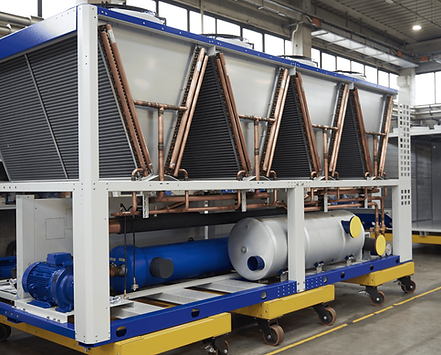How Do Heat Pump Cooling Systems Work?
01. Evaporation
Most systems are split between an indoor unit and an outdoor unit. Warm indoor air is blown over the evaporator coils in the indoor unit, and the refrigerant inside the coils absorbs this heat and evaporates. This air then circulates into the indoor space to reduce the overall temperature.
01. Evaporation
Most systems are split between an indoor unit and an outdoor unit. Warm indoor air is blown over the evaporator coils in the indoor unit, and the refrigerant inside the coils absorbs this heat and evaporates. This air then circulates into the indoor space to reduce the overall temperature.
02. Compression
The refrigerant gas carrying the absorbed heat moves to the compressor, which is located in the outdoor unit. In this section of the unit, the pressure and temperature of the refrigerant increase, making it ready for condensation.
02. Compression
The refrigerant gas carrying the absorbed heat moves to the compressor, which is located in the outdoor unit. In this section of the unit, the pressure and temperature of the refrigerant increase, making it ready for condensation.
03. Condensation
This high-pressure, high-temperature refrigerant gas travels to the condenser unit which draws in outside air and blows it over the condenser coils, allowing heat transfer to occur. As the refrigerant releases its heat, it condenses back into a high-pressure liquid.
03. Condensation
The vapor is directed to a condenser unit which uses coils or fins to expose the refrigerant to the outside air. Fans on the air-cooled chiller system draw cool air over this area, causing the refrigerant to condense back into a liquid.
04. Expansion
After condensation has occurred, the high-pressure liquid refrigerant passes through an expansion valve which reduces its pressure and temperature. Now the refrigerant is a cold, low-pressure liquid once more and can re-enter the evaporator to continue the cooling process.
04. Expansion
After condensation has occurred, the high-pressure liquid refrigerant passes through an expansion valve which reduces its pressure and temperature. Now the refrigerant is a cold, low-pressure liquid once more and can re-enter the evaporator to continue the cooling process.
The Benefits of a Heat Pump Installation with CF Chiller
Energy Efficiency
Our cooling systems are energy-efficient because they use less electricity to move heat compared to traditional cooling methods. The energy savings experienced by opting for a heat pump installation will result in lower utility bills, making them a cost-effective cooling solution.
Year-Round Comfort
These systems can provide both cooling and heating functions. This dual functionality makes them a great choice for all-season climate control, with the ability to be placed indoors and outdoors.
Environmentally Friendly
These units have a lower environmental impact due to their high efficiency and use of eco-friendly refrigerants. They reduce greenhouse gas emissions and reliance on fossil fuels, promoting a greener, more sustainable future.
Long Lifespan and Reliability
With proper maintenance, they can last 15-20 years or more, providing reliable and consistent cooling and heating. Their robust design ensures minimal downtime and maintenance costs.







